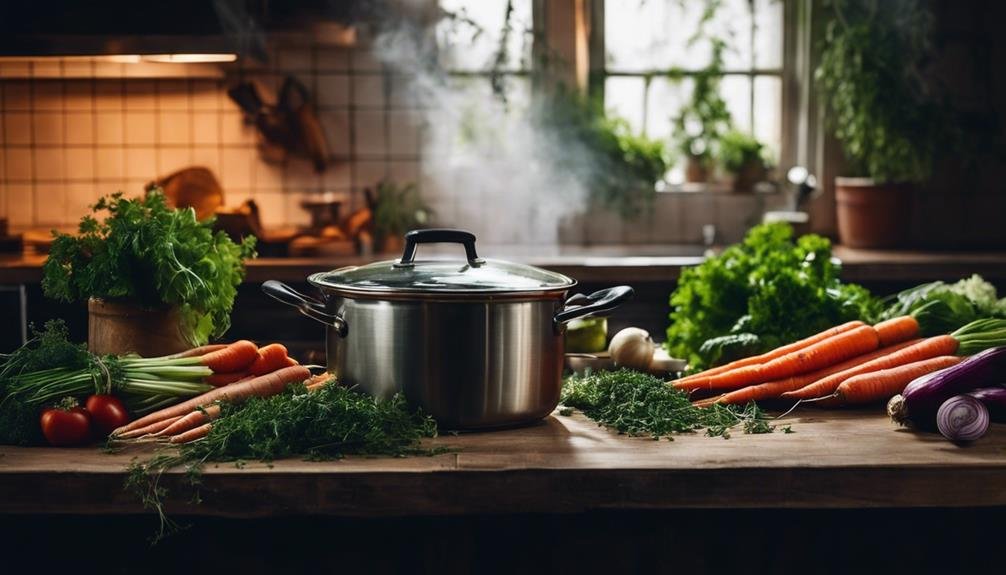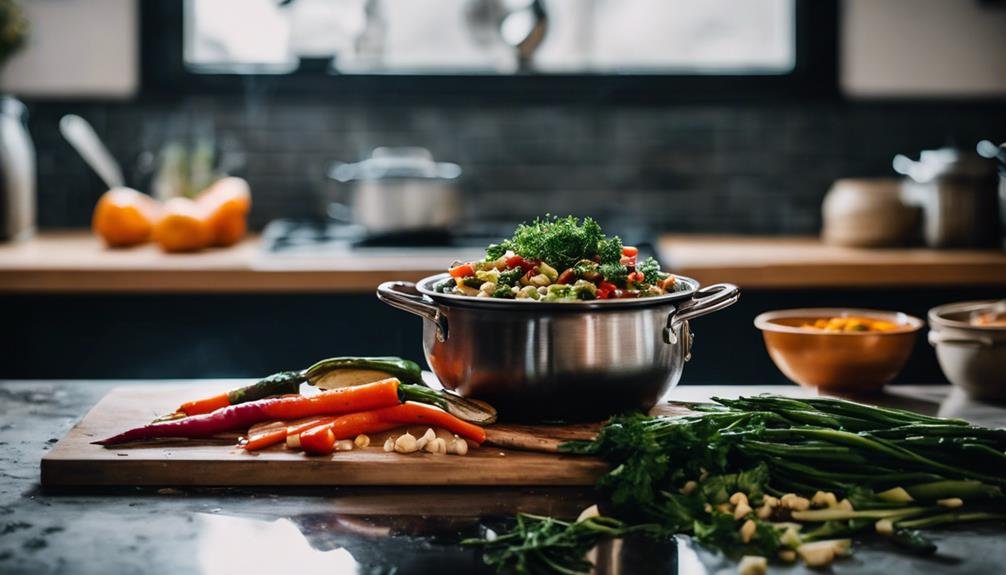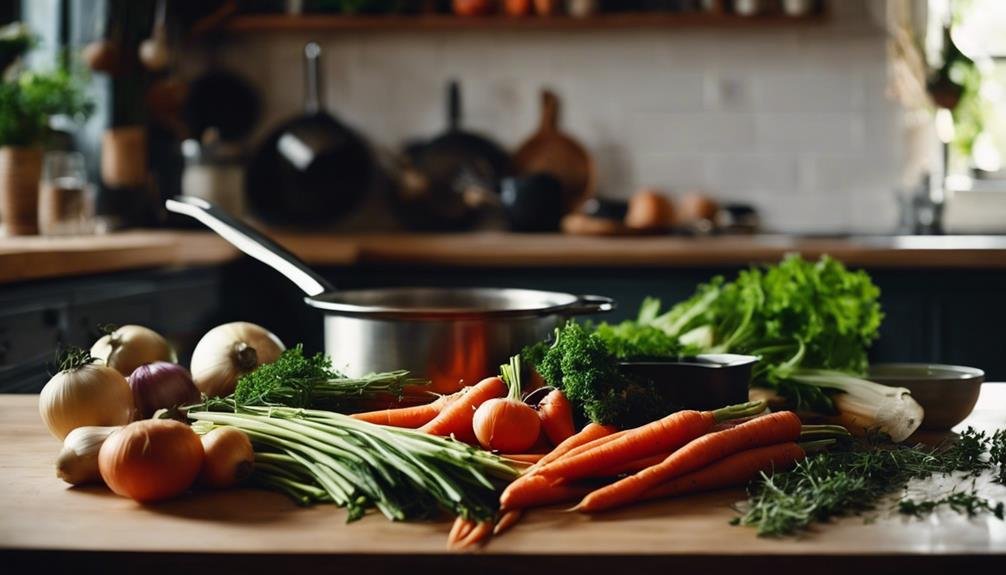Did you know that nearly 75% of home cooks admit they’ve never attempted making their stock, believing it’s too complex? Well, you’re about to join the enlightened 25%.
Mastering cooking stock isn’t just about boiling bones; it’s an art form that blends science and intuition. You’ll learn to select ingredients, balance flavors, and achieve the perfect simmer.
But why should you bother when the store-bought variety sits readily on shelves?
Stick around, and you’ll discover the secrets to elevating your soups, sauces, and stews from good to gourmet while using leftovers you might have tossed.
Cooking Stock Key Takeaways
- Use fresh, organic ingredients and experiment with combinations for flavorful stocks.
- Slow-cook bones and vegetables, skimming impurities for a clear, rich base.
- Store stock properly in the fridge or freezer to preserve freshness.
- Troubleshoot common issues like cloudiness or blandness with simple adjustments.
Essential Tools and Equipment
Diving into the art of making stock, you’ll quickly realize that a trusty stockpot and a keen eye for precision are your best allies in the kitchen. Selecting the right equipment isn’t just helpful; it’s essential for crafting stocks that’ll make your soups and sauces sing.
Imagine a stockpot with a flat bottom and straight sides sitting on your stove. Why this shape, you ask? It guarantees even cooking and the best flavor extraction, ensuring every spoonful of stock is as rich and nuanced as possible.
But let’s not stop there. Envision a filter in your hand, skimming away impurities to achieve that crystal-clear quality in your stock. Perfection in stock making comes down to the details—using a scale for precise ingredient proportions and a thermometer to monitor the temperature, ensuring flavors are drawn out just right.
And for those seeking to add an extra layer of depth to their stocks, an oven becomes your secret weapon. Roasting bones and vegetables before they even hit the pot can transform your stock from good to unforgettable. So, as you begin your stock-making journey, remember these tools are more than just kitchen gadgets; they’re the key to unlocking a world of flavor.
Selecting Your Ingredients
Starting on your stock-making journey, remember that the backbone of a savory, soul-warming stock lies in carefully selecting high-quality ingredients. You’re not just tossing leftovers into a pot; you’re curating a foundation that’ll uplift one meal to the next level. A good choice? Fresh, organic, and locally sourced ingredients. They’re not just buzzwords; they’re your ticket to a stock as rich in flavor and nutrients.
Think of your stock as a symphony, where every ingredient plays a pivotal role. Bones—be it beef, chicken, or pork—lay down the base notes, while the vegetables—onions, carrots, and celery—add the mids. Herbs and aromatics? They’re the high notes that bring everything together. Don’t shy away from salt, peppercorns, bay leaves, and parsley; these seasonings are the encore your stock deserves.
And here’s where it gets fun: experiment. Mix and match ingredients to find what sings to your palate. Remember, every good choice you make in selecting your ingredients adds depth to your stock and brings a touch of magic to every dish it graces.
The Stock-Making Process

Once you’ve gathered your premium ingredients, it’s time to roll up your sleeves and immerse yourself into the heart of stock-making: a simmering dance of flavors and aromas that promises to elevate your culinary creations.
The stage is set with a pot of stock, where bones, vegetables, and herbs take their places, ready to perform under the spotlight of slow cooking.
Your role? The diligent director oversees the extraction of rich flavors and nutritious elements. But it’s not all smooth sailing. As the plot thickens, you’ll skim off impurities and fat, ensuring a clean finish as clear as your culinary vision.
Remember, patience is your co-star in this production. Slow cooking over low heat unfolds the narrative, allowing flavors to develop, mingle, and reach their peak performance.
As the curtain falls, straining the stock guarantees a smooth liquid free from the remnants of its solid cast members. The intricate and deliberate process reveals the essence of cooking: transforming humble ingredients into a foundation that enriches every dish it graces.
Storing and Preserving Stock
After immersing yourself in the art of stock-making, it’s important to store and preserve your liquid gold properly, ensuring its rich flavors are ready whenever you are. First, grab those plastic containers with tight lids. They’re your new best friends for keeping homemade stocks and broths fresh and avoiding the dreaded spill in the fridge. You’re not just making stocks; you’re crafting culinary treasures.
Now, if you fancy yourself a bit of a meal prep maestro, freezing stock in ice cube trays is a game-changer. You can pop out what you need, adding a splash of genius to your dishes de la minute. For the short term, remember the fridge is your stock’s cozy retreat for up to 4-5 days, keeping it in tip-top shape.
Feeling adventurous? Plunge into the world of dehydration to create dried bouillon cubes from your concentrated stock. It’s long-term preservation with a sprinkle of magic. And for those gelatinous stocks, a terrine mold isn’t just chic; it’s practical, giving you that perfect slice of flavor heaven.
Troubleshooting Common Issues

Even the most meticulous stock-making endeavors can hit a snag, but fear not—there are savvy fixes for common culinary conundrums. Let’s explore the solutions for ensuring your stock remains a star component in your culinary arsenal.
| Common Issue | Cause | Savvy Fix |
|---|---|---|
| Cloudy Appearance | Vigorous boiling | Keep it at a gentle simmer |
| Unpleasant Flavors | Over-seasoning/old ingredients | Use fresh, quality components |
| Overly Salty | Heavy-handed seasoning | Dilute with unsalted liquid or add potatoes |
| Inconsistent Gelatinous Texture | Imbalanced ratio of collagen-rich ingredients | Adjust the ratio of bones and connective tissues |
| Blandness | Lack of aromatic depth | Add aromatic veggies, herbs, or spices late in the cooking process |
Frequently Asked Questions
What Are the 4 Elements of Stock Cooking?
Water, bones, aromatics, and time are the four elements essential for cooking stock. These components combine to create a flavorful and rich broth, a fundamental base in many culinary dishes.
What Are the 4 Basic Parts to All Stocks?
When exploring the stock market, it’s essential to understand its four basic components: shares, dividends, capital gains, and voting rights. These elements combine to create a dynamic financial ecosystem that can significantly enhance your investment portfolio.
What Are the 4 Steps to Making a Stock?
The four steps to making stock are roasting bones and vegetables, simmering them with water, skimming off impurities, and straining the liquid. This process ensures your stock is rich, clear, and smooth—crucial for elevating any dish.
What Is the Basic Ratio for Cooking Stock?
The basic ratio for cooking stock is 1 pound of bones to 1 gallon of water. As you explore the fundamentals, understand that this ratio can be adjusted according to your preference for a more concentrated flavor or a lighter broth.
Conclusion
Congratulations! You’ve just dipped your toes into the flavorful world of homemade stocks. Armed with the right tools, choice of ingredients, and patience, you’re now equipped to simmer your way to culinary greatness.
Remember, the magic of stock-making lies in its simplicity and the power to transform scraps into gold. So, go ahead and stash that liquid gold in your fridge. Troubleshoot with flair, and let your kitchen adventures be boundless.
Happy simmering!

































